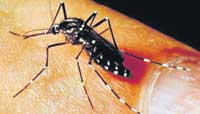
|
On the threshold of chikungunya It masquerades as dengue but the good news is that it is not as deadly as some strains of dengue such as the haemorrhagic kind. As chikungunya spreads in South Asia, including southern India, Consultant Epidemiologist Dr. Ananda Amarasinghe was quick to reassure Sri Lankans that this viral disease had not been detected yet in our country. "There are only suspected cases," he said adding that the Epidemiology Unit was attempting to put in place facilities to enable the detection of chikungunya.
From February to October 10, 2006, the WHO Regional Office for South-East Asia has reported that 151 Indian districts in eight states have been affected by this viral fever. The affected areas are Kerala, Tamilnadu (in close proximity to Sri Lanka and with a constant flow of displaced, back and forth), Andhra Pradesh, Andaman & Nicobar Islands, Karnataka, Maharashtra, Gujarat, Madhya Pradesh and Delhi. More than 1.25 million suspected cases have been reported from India. Both chikungunya and dengue viruses are transmitted to humans by the bites of infected mosquitoes, says Dr. Amaras-inghe, adding that Aedes aegypti is the vector which transmits both diseases. "Chikungunya is not transmitted from person to person. “If the symptoms of a fever patient are similar to those of dengue, but the blood tests for the virus/antibody come negative, then doctors should look into the possibility of the patient having contracted chikungunya. Sometimes the patient may not even have a temperature, only a patchy red rash on the body and hands and legs and joint pains, mainly of the wrists, knees, ankles or small joints." Stressing that the elimination of mosquito breeding sites would prevent both chikungunya and dengue, he says this mosquito breeds close to human habitation and multiplies in collections of stagnant water, mostly in artificial containers. Tyres put on roofs to keep the roofing sheets down, blocked gutters or drainage, bird-baths, coconut shells, yoghurt or any plastic containers, vases and ponds without fish could be its breeding areas. His message to the people is clear - Get rid of mosquitoes and their breeding grounds and you can prevent not only chikungunya but also dengue.
|
| || Front
Page | News
| Editorial
| Columns
| Sports
| Plus
| Financial
Times | International
| Mirror
| TV
Times | Funday
Times || |
| |
Copyright
2006 Wijeya
Newspapers Ltd.Colombo. Sri Lanka. |
